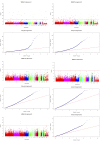Identifying Genetic Differences Between Dongxiang Blue-Shelled and White Leghorn Chickens Using Sequencing Data
- PMID: 29187421
- PMCID: PMC5919749
- DOI: 10.1534/g3.117.300382
Identifying Genetic Differences Between Dongxiang Blue-Shelled and White Leghorn Chickens Using Sequencing Data
Abstract
The Dongxiang Blue-shelled chicken is one of the most valuable Chinese indigenous poultry breeds. However, compared to the Italian native White Leghorn, although this Chinese breed possesses numerous favorable characteristics, it also exhibits lower growth performance and fertility. Here, we utilized genotyping sequencing data obtained via genome reduction on a sequencing platform to detect 100,114 single nucleotide polymorphisms and perform further biological analysis and functional annotation. We employed cross-population extended haplotype homozygosity, eigenvector decomposition combined with genome-wide association studies (EigenGWAS), and efficient mixed-model association expedited methods to detect areas of the genome that are potential selected regions (PSR) in both chicken breeds, and performed gene ontology (GO) enrichment and quantitative trait loci (QTL) analyses annotating using the Kyoto Encyclopedia of Genes and Genomes. The results of this study revealed a total of 2424 outlier loci (p-value <0.01), of which 2144 occur in the White Leghorn breed and 280 occur in the Dongxiang Blue-shelled chicken. These correspond to 327 and 94 PSRs containing 297 and 54 genes, respectively. The most significantly selected genes in Blue-shelled chicken are TMEM141 and CLIC3, while the SLCO1B3 gene, related to eggshell color, was identified via EigenGWAS. We show that the White Leghorn genes JARID2, RBMS3, GPC3, TRIB2, ROBO1, SAMSN1, OSBP2, and IGFALS are involved in immunity, reproduction, and growth, and thus might represent footprints of the selection process. In contrast, we identified six significantly enriched pathways in the Dongxiang Blue-shelled chicken that are related to amino acid and lipid metabolism as well as signal transduction. Our results also reveal the presence of a GO term associated with cell metabolism that occurs mainly in the White Leghorn breed, while the most significant QTL regions mapped to the Chicken QTL Database (GG_4.0) for the Dongxiang Blue-shelled breed are predominantly related to lesions, bone mineral content, and other related traits compared to tibia length and body weight (i.e., at 14, 28, 42, and 70 d) in the White Leghorn. The results of this study highlight differences in growth, immunity, and egg quality traits between the two breeds, and provide a foundation for the exploration of their genetic mechanisms.
Keywords: EMMAX; EigenGWAS; XP-EHH; chicken; functional annotation; selected regions.
Copyright © 2018 Zhao et al.
Figures



Similar articles
-
Genome-wide association study reveals novel variants for growth and egg traits in Dongxiang blue-shelled and White Leghorn chickens.Anim Genet. 2016 Oct;47(5):588-96. doi: 10.1111/age.12456. Epub 2016 May 11. Anim Genet. 2016. PMID: 27166871
-
Molecular phylogenetic analysis of Chinese indigenous blue-shelled chickens inferred from whole genomic region of the SLCO1B3 gene.Poult Sci. 2015 Aug;94(8):1776-86. doi: 10.3382/ps/pev146. Epub 2015 Jun 11. Poult Sci. 2015. PMID: 26069255
-
Genome-wide association study and a post replication analysis revealed a promising genomic region and candidate genes for chicken eggshell blueness.PLoS One. 2019 Jan 23;14(1):e0209181. doi: 10.1371/journal.pone.0209181. eCollection 2019. PLoS One. 2019. PMID: 30673708 Free PMC article.
-
The study of selection signature and its applications on identification of candidate genes using whole genome sequencing data in chicken-a review.Poult Sci. 2023 Jun;102(6):102657. doi: 10.1016/j.psj.2023.102657. Epub 2023 Mar 16. Poult Sci. 2023. PMID: 37054499 Free PMC article. Review.
-
Genome-wide association study of body weight in Wenshang Barred chicken based on the SLAF-seq technology.J Appl Genet. 2018 Aug;59(3):305-312. doi: 10.1007/s13353-018-0452-7. Epub 2018 Jun 27. J Appl Genet. 2018. PMID: 29946990 Review.
Cited by
-
Identifying the unique characteristics of the Chinese indigenous pig breeds in the Yangtze River Delta region for precise conservation.BMC Genomics. 2021 Mar 2;22(1):151. doi: 10.1186/s12864-021-07476-7. BMC Genomics. 2021. PMID: 33653278 Free PMC article.
-
Genetic Diversity and Selection Signatures in Synthetic-Derived Wheats and Modern Spring Wheat.Front Plant Sci. 2022 Jul 12;13:877496. doi: 10.3389/fpls.2022.877496. eCollection 2022. Front Plant Sci. 2022. PMID: 35903232 Free PMC article.
-
Genome-wide detection of CNVs and their association with performance traits in broilers.BMC Genomics. 2021 May 17;22(1):354. doi: 10.1186/s12864-021-07676-1. BMC Genomics. 2021. PMID: 34001004 Free PMC article.
-
Fourth Report on Chicken Genes and Chromosomes 2022.Cytogenet Genome Res. 2022;162(8-9):405-528. doi: 10.1159/000529376. Epub 2023 Jan 30. Cytogenet Genome Res. 2022. PMID: 36716736 Free PMC article. Review. No abstract available.
-
Study on the transcriptome for breast muscle of chickens and the function of key gene RAC2 on fibroblasts proliferation.BMC Genomics. 2021 Mar 6;22(1):157. doi: 10.1186/s12864-021-07453-0. BMC Genomics. 2021. PMID: 33676413 Free PMC article.
References
-
- Dargel C., Bassani-Sternberg M., Hasreiter J., Zani F., Bockmann J. H., et al. , 2015. T cells engineered to express a T-cell receptor specific for glypican-3 to recognize and kill hepatoma cells in vitro and in mice. Gastroenterology 149: 1042–1052. - PubMed
-
- Ennis S., 2007. Linkage disequilibrium as a tool for detecting signatures of natural selection. Methods Mol. Biol. 376: 59–70. - PubMed
Publication types
MeSH terms
LinkOut - more resources
Full Text Sources
Other Literature Sources
Miscellaneous
